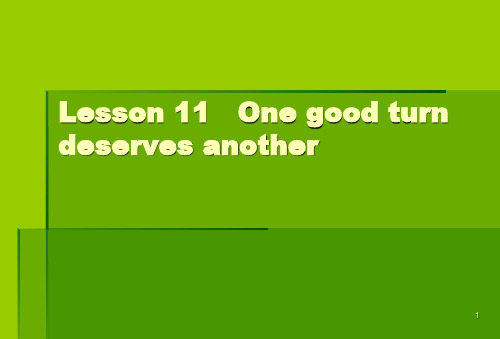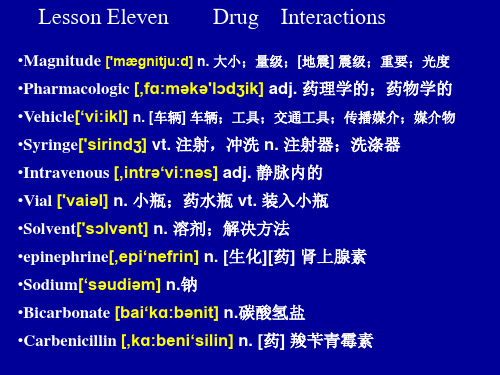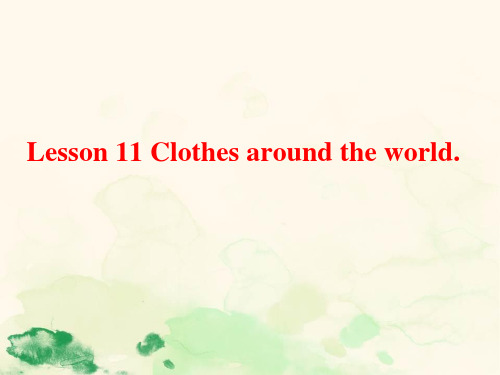lesson11
新概念英语二册Lesson 11学习资料

Lesson 11 One good turn deserves another 礼尚往来First listen and then answer the question.听录音,然后回答以下问题。
Who paid for Tony's dinner?I was having dinner at a restaurant when Tony Steele came in. Tony worked ina lawyer's office years ago, but he is now working at a bank. He gets a good salary, but he always borrows money from his friends and never pays it back. Tony saw me and came and sat at the same table. He has never borrowed money from me. While he was eating, I asked him to lend me twenty pounds. To my surprise, he gave me the money immediately. 'I have never borrowed any money from you,' Tony said, 'so now you can pay for my dinner!'turn [tə:n] n. 行为,举止deserve [di'zə:v] v. 应得到,值得lawyer ['lɔ:jə] n. 律师bank [bæŋk] n. 银行salary ['sæləri] n. 工资immediately [i'mi:djətli] adv. 立刻我正在一家饭馆吃饭,托尼.斯蒂尔走了进来。
新概念英语第二册Lesson11(课堂PPT)

2
★turn n. 行为, 举止
▪turn n.(帮助或损害他人的)举动、行为 ▪do sb. a good / an ill turn ▪做对某人有利/不利的事。 ▪ Yesterday George did me a good/an ill turn. 乔治昨 天做了一件对我有利/不利的事。 ▪ He is always ready to do a turn for others. 他总是乐 于为他人做好事。
前 ▪ 1 )pay“偿还(债务等)”, ▪ pay back 还钱 ▪ 2)Vt. & Vi. “付,支付(价款、账单)”。 ▪ Pay for sth. / sb. 为某人或某物付款。 ▪ Pay+ 价钱 / 账单 支付钱/账单。 ▪ I paid 100 Yuan for the dress. ▪ I paid the bill.
▪ 工资很低:a poor salary; a low salary
15
▪ 2 borrow 借入 ▪ borrow sth from sb ▪ lend 借出 ▪ lend sth to sb / lend sb sth
16
▪ 3pay 在这里的意思是“偿还(债务等)”,还可解 释为“付,支付(价款、账单)等”。Pay 既是及 物动词也可以是不及物动词。
21
▪(2) 付出代价;受惩罚 ▪ He will have to pay for this foolish behaviour. ▪他将要为这种愚蠢行为而受报应。 You will pay for your dishonesty. ▪你不老实,总有一天会吃苦头的。 He paid for his laziness by not passing his exam. 他没有通过考试,这是他懒而受到的惩罚。
新概念英语Lesson11

5. This tie is his (he).
Homework
单词 4+1+1 练习册L11 L11笔记 背诵并默写L11 L11表演视频
black white blue
yellow green
red
purple greyБайду номын сангаас
It’s not my shirt. D:This is my shirt.
My shirt’s blue. T: Is this shirt Tim’s? D:Perhaps it is, sir.
Tim’s shirt’s white.
T:Tim! T1:Yes, sir? T: Is this your shirt? T1:Yes, sir. T: Here you are.
A.One B.Two
(A)2.What color is Tim's shirt?
A.white B.black
whose blue white perhaps catch
/hu:z/ /blu:/ /waɪt/
pron.谁的 adj.蓝色的 adj.白色的
/pəˈhæps/ adv.大概
/kætʃ/ v.抓住
入门考
1. That is my shirt.(同义句) 2. This is _h_e_r__ (she) dress. 3. This is not __y_ou_r___(you) suit. 4. That is _h_is___(he) father. 5. That is my sister’s watch?
whose /hu:z/ pron.谁的 blue /blu:/ adj.蓝色的 perhaps /pə'hæps/adv.大概 white /waɪt/adj.白色的 catch /kætʃ/v.抓住
兽医专业英语(扬州大学)lesson 11

Lesson Eleven Drug Interactions
•Ketamine[‘ketəmi:n] n. [药] 氯胺酮(一种麻醉剂 ) •Barbiturate[,bɑ:'bitjurət] n. [药] 巴比土酸盐;[药] 巴比妥酸盐 •Methylprednisolone[,meθilpred'nisələun] n. [药] 甲基强的松龙 •Succinate[‘sʌksineit] n. [有化]丁二酸盐;琥珀酸盐 •Calcium['kælsiəm] n. [化学] 钙 •Gluconate['ɡlu:kəneit] n. [有化] 葡糖酸盐 •Hydrolysis [hai‘drɔlisis] n. 水解作用 •Reduction [ri'dʌkʃən] n. 减少;下降;缩小 •Complexation [kɔmplek'seiʃ(ə)n] n. 络合;络合作用(complex的名词) •Precipitation [pri,sipi‘teiʃən] n. [化学] 沉淀;冰雹;坠落;鲁莽
In vivo drug interactions may result in diminished or enhanced drug effects, expression of a new or different effect, or perhaps no obvious pharmacodynamic change but altered pharmacokinetics that may not be clinically apparent. Some drug interactions are advantageous and are exploited (开发,开拓 ) in therapy. Many others ( drug interactions ) are potentially deleterious. A documented or potential drug interaction is rarely an absolute contraindication for concurrent administration and hence becomes a component of risk assessment in therapeutic decision making.
新概念第一册Lesson11

D: This is my shirt. My shirt's blue.
1. My shirt`s=My shirt is…
T: Is this shirt Tim's?
1 .Is this shirt Tim's? Tim`s再名词后面加上“s”构成名词所有 格,翻译成“的”。
D: Perhaps it is, sir. Tim's shirt's white.
单词讲解
father=dad father-in-law 岳父;公公 mother=mom=mum mother-in-law 岳母;婆婆 father+mother=partents father/mother=parent His parents are in Germany.
★catch v. 抓住 ① v. 接住,拦住 ② v. 逮住,捕获 catch a thief ③ v. 染上(疾病) catch a cold 患感冒
单词学习
father ['fɑ:ðə]n.父亲 mother ['mʌðə]n.母亲 blouse [blaʊz]n.女衬衫 sister ['sɪstə]n.姐,妹 tie [taɪ]n.领带 brother ['brʌðə]n.兄,弟 his [hɪz]possessive adjective 他的 her [hə:]possessive adjective 她的
特殊疑问词whose
用于询问所有关系。 如果对形容词性物主代词、名词性物主代词、名 词所有格(形容词性和名词性)进行提问,就要 用到whose。(对表示“…的” 提问) 特殊疑问句构成:特殊疑问词+一般疑问句 This is my shirt. (对my提问) Whose is this shirt? =Whose shirt is this? shirt既可以放在whose后,也可以不放
冀教版七年级上册lesson 11课件

1. —I like your new shoes.
—______
A. Thank you.
B. That’s right.
C. I know.
D. Great!
2. —Is this ______ old car?
—No, it’s ______ new car.
A. an; an
B. an; a
Can you say something about the picture?
China uniforms
China sweaters
the U.S. colorful clothes
Where is the woman from?
She is from_I_n_d_i_a______.
What is the woman wearing? She is wearing_a__s_a_ri___________. How does she look? She looks_b__ea_u__ti_fu__l /_p_r_e_t_ty__/n_i_c_e_ _i_n_h_e_r__s_a_ri_.
C. a; a
D. a; an
3. Is Li Ming a boy ______ a girl?
A. and B. or C. too D. but
4. I have a new watch ______ my mom.
A. at B. from C. on D. in
5. —Do you like pink or red?
Where are the people from?
They are from__th_e__U_._S____.
What are the people wearing? They are wearing_u_n_i_fo_r_m__s_f_o_r_w__o_r_k. How do they look? They look_b_e_a_u_t_if_u_l_/_p_r_et_t_y_/_n_ic_e__ _in__t_h_e_u_n_i_f_o_rm__s__.
Lesson11教案

Lesson11教案(六年级)教学目标:1,理解和运用:__What are you interested in ?___I’m interested in ... .2,听、说、读三个短语:play computer games;make dolls;take photos.3,理解、听读Lesson11。
4,培养学生健康的爱好。
教学重点:1,理解和运用:__What are you interested in ? __I’m interested in ...2,理解、听读Lesson11。
课前准备:ppt 、录音机、磁带。
教学过程:Step1,Revision1, Let’s chantCook shows me a good cook book.The book is about a good cook.His hobby is collecting books.(group work)Look!Look! Have a look!2,Revision (pair work)T:what’s your hobby ?S1:My hobby is collecting maps.T:What’s your dad’s hobby ?S1: His hobby is playing pingpong.T:Good!Sit down. Let’s make dialogue like this.SS: ...T: Show your dialogues.SS: ....Step2,Presentation1,T: Hello, What’s your hobby ?S1:My hobby is fishing.T: Are you interested in reading ?(你对读书感兴趣吗?)S1: Yes,I am.T: Are you interested in planting flowers ?S2:No, I’m interested in cooking meals.T: What are you interested in ?S3: I’m interested in playing volleyball.....2,present ppt1,T: What are you interested in ?S1: I’m interested in playing computer games.T: What are you interested in ?S2: I’m interested in making dolls..... .2,Phrases :Play computer games ; make dolls ; take photosT; I’ll ask some students to read the phrasesS1: ...S2: ...3,TextT: Please listen and answer1, What’s Zhou Pei interested in ?2,What’s Yang Ming interested in ?3,What’s Lisa interested in ?SS: ...T: Look here.What is the baby doing ?SS: ...(It is crying.)T:What is the baby doing ?SS: It is Smiling.T: What is mother doing ?SS: She is feeding the baby.T:Ok, Let’s listen and read the text.Step3 practice and consolidation.1, read the text.2,The present continuous tense.(PPT)T:What is dad doing ?SS: He is cooking meals.T:What is mother doing ?SS: She is cooking meals....现在进行时:表示动作正在进行。
Lesson 11 现在进行时 过去进行时

1.过去进行时可表示按计划、安排过去某时 刻将要发生的动作。 He said they were leaving for Beijing this afternoon. 2.动词hope, wonder等的过去进行时常用 来表示提出要求,虽然表示现在的内容,但 语气比一般现在时或一般过去时要委婉。 I was wondering whether you could come to join us.
3.过去进行时中有always, forever, continually, constantly修饰时,表示说话人的赞赏或厌烦的感情。 He was always thinking of others.
4.由when引导的时间状语从句,主句用过去进行 时,从句应用一般过去时;如果从句和主句的动作 同时发生,两句都用过去进行时的时候,多用 while引导: When the teacher came in, we were talking. While we were talking, the teacher came in. They were singing while we were dancing
2.特殊疑问句:疑问词+be+主语+v-ing+其它? What is he doing?
用法
1.以Look!或Listen!开头的句子提示我们说话时动作 正在进行,应用现在进行时。 Look!The children are playing games over there. Listen!Who's singing in the classroom? 2.当句子中有now(现在)时,常表示说话时动作正在 进行,这时也常用现在进行时。 We are reading English now.
- 1、下载文档前请自行甄别文档内容的完整性,平台不提供额外的编辑、内容补充、找答案等附加服务。
- 2、"仅部分预览"的文档,不可在线预览部分如存在完整性等问题,可反馈申请退款(可完整预览的文档不适用该条件!)。
- 3、如文档侵犯您的权益,请联系客服反馈,我们会尽快为您处理(人工客服工作时间:9:00-18:30)。
Lesson 11 Toys
教学目标
1.学生能听懂、会说、认读并书写词汇:toy, ball, kite, play with
2.学生能认读、理解并运用句型结构:On Saturday, I play with my friend. /We fly kites./We play catch with a ball. /Jenny plays with her toys.
3.学生能理解字母组合sh,ch,th在单词中的发音及其规则。
教学重点:掌握本课四会单词。
教学难点:play with与play…with的区别与应用
教具:教学光盘、前一课短语的图片、新单词toy, ball, kite的图片及实物
教学过程
一、Class opening and review
1.Greeting. What do you do on Saturday?卡片复习一星期七天的词汇,并谈论星期六的活动。
出示图片,复习前一课短语内容:brush my teeth,wash my face,brush my hair,put on my clothes
Lesson Book:今天我们学习与玩耍有关的英语短语及句子。
二、New concepts:
1. What do you do no Saturday?
(1)学习新词toy, ball, kite。
利用卡片或实物问答:What’s this? It’s a ___。
板书单词:toy, ball, kite,让志愿者拿出实物(玩具、球、风筝)与单词相匹配。
(2)学习play:用多种方法解释概念,可以用跳绳、踢毽子、传球等展示玩耍。
Let’s play with this ball. Let’s play with thes e toys.
(3)看书第一部分,播放光盘,并讨论发生了什么。
出示问题:What day is it? What do Li Ming, Jenny and Danny do first? What do Li Ming, Jenny and Danny do last?
Practice 练习:4人小组学习,一名学生问:What do you do no Saturday?其他学生轮流说做什么
2. Let’s do it!
Group work. Ask and answer. 学生看书,老师解释如何做活动。
读一读例句,然后分小组进行问答。
What do you do no Saturday? I…
3. Letters and sounds
将字母组合sh,ch,th及包含它们的单词写在黑板上,先让学生读出单词,再试着读一读字母组合的音素,老师及时纠正并读出正确读音,尽快让学生明白音素,并能读出该音素和相应的单词。
4.巩固检验Check for understanding:活动手册page26
三、Class closing
Now, let’s play with our toys. 留几分钟给学生玩,并祝贺他们今天的学习和表现。
四、板书设计
Lesson 11 Toys
toy, ball, kite
What do you do no Saturday?
I play with my friend. We fly kites.
We play catch with a ball.
Jenny plays with her toys.。
